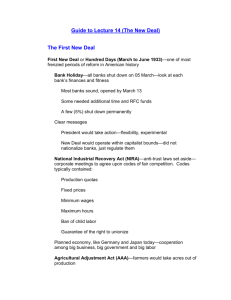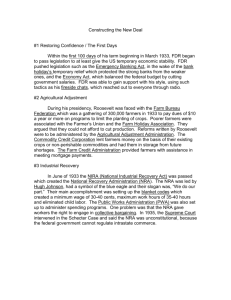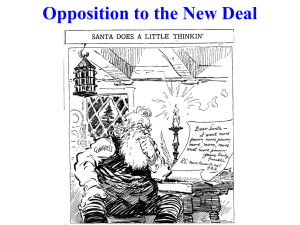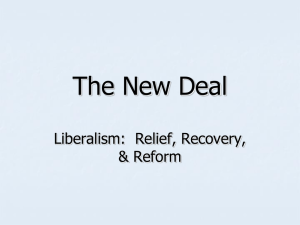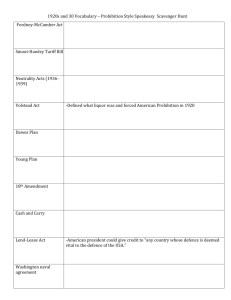New Deal Flashcards filled in
advertisement
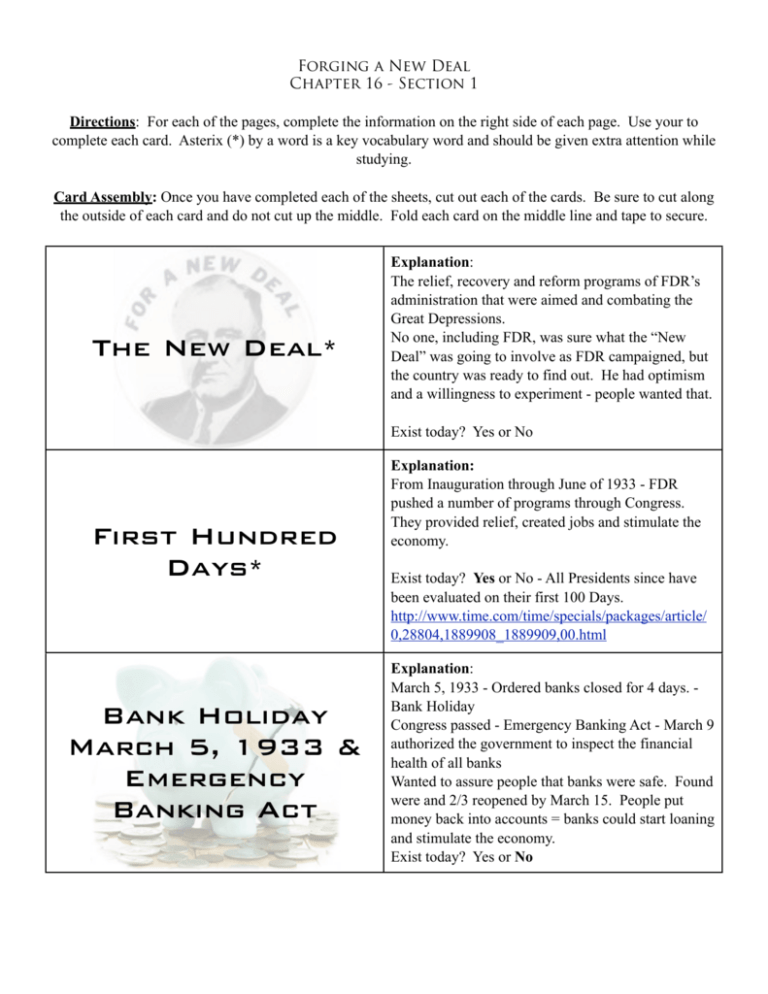
Forging a New Deal Chapter 16 - Section 1 Directions: For each of the pages, complete the information on the right side of each page. Use your to complete each card. Asterix (*) by a word is a key vocabulary word and should be given extra attention while studying. Card Assembly: Once you have completed each of the sheets, cut out each of the cards. Be sure to cut along the outside of each card and do not cut up the middle. Fold each card on the middle line and tape to secure. The New Deal* Explanation: The relief, recovery and reform programs of FDR’s administration that were aimed and combating the Great Depressions. No one, including FDR, was sure what the “New Deal” was going to involve as FDR campaigned, but the country was ready to find out. He had optimism and a willingness to experiment - people wanted that. Exist today? Yes or No First Hundred Days* Bank Holiday March 5, 1933 & Emergency Banking Act Explanation: From Inauguration through June of 1933 - FDR pushed a number of programs through Congress. They provided relief, created jobs and stimulate the economy. Exist today? Yes or No - All Presidents since have been evaluated on their first 100 Days. http://www.time.com/time/specials/packages/article/ 0,28804,1889908_1889909,00.html Explanation: March 5, 1933 - Ordered banks closed for 4 days. Bank Holiday Congress passed - Emergency Banking Act - March 9 authorized the government to inspect the financial health of all banks Wanted to assure people that banks were safe. Found were and 2/3 reopened by March 15. People put money back into accounts = banks could start loaning and stimulate the economy. Exist today? Yes or No Glass-Steagall Banking Act & FDIC 1933 The Federal Securities Act & SEC May 1933 Explanation: To increase public confidence in banks - GlassSteagall Banking Act 1933. Created the Federal Deposit Insurance Corporation (FDIC) to insure bank deposits up to $5,000 dollars Exist today? Yes or No Look for the FDIC sticker at the next bank you visit. Explanation: Wanted to correct the problems of the stock market. Congress passed the Federal Securities Act - May 1933 - required companies to provide info. about finances if they offered stock. Securities and Exchange Commission was created to regulate the stock market. Federal Reserve Board the power to regulate margin buying for stocks. Exist today? Yes or No - Ask Martha Stewart. Federal Emergency Relief Administration (FERA) May 1933 Public Works Programs* Explanation: FDR’s attempt to help overburdened local relief agencies. FERA - job to give funds to local relief Harry Hopkins (longtime friend of FDR and former settlement worker) was in charge HH quote “Give a man a dole (handout), and you save his body and destroy his spirit. Give him a job and pay him an assured wage and you save both body and spirit.” Exist today? Yes or No Explanation: Vocabulary word = government-funded projects to build public facilities. A number of the New Deal programs were public works programs. Exist today? Yes or No The government still fund and support public works programs. Still build dams and support business. Civil Works Administration November 1933 Civilian Conservation Corps (CCC)* March 1933 National Industrial Recovery Act (NIRA) June 1933 National Recovery Administration (NRA) June 1933 Explanation: Put the unemployed to work building and improving roads, parks, airports and other facilities. Was a tremendous morale booster to its 4 million workers. Exist today? Yes or No Explanation: FDR’s favorite program. CCC put more than 2.5 million young, unmarried men to work maintaining forests, beaches and parks. Earned $30 a month but lived in camps free of charge with food, medical and job training. They sent $25 of their money home to their family. Exist today? Yes or No - Northern woods of PA have fire trails and fire tires built by the CCC Explanation: Big decline in prices & businesses had failed and unemployment going up. NIRA tried to help prices and established the NRA Exist today? Yes or No Explanation: Set out to balance the unstable economy with extensive planning. Made industrial codes to create fair business practices. Codes about wages, working conditions, production, and prices - made minimum wage. Helped unions gain collective bargaining. Criticism - some codes written by big business so said were bias against workers. Worked for awhile, but wages and prices rose and buying slowed. Exist today? Yes or No - Some of standards still exist. Public Works Administration Home Owners’ Loan Corporation (HOLC) Explanation: NIRA program and the most visible! Sec. of Interior Harold Ickes was in charge. Launched projects like Grande Coulee Dam (Columbia River -Wash) / New York Triborough Bridge and causeway to Key West. Exist today? Yes or No Administration gone, but work is still everywhere. McKnight Road was worked on and has a marker at the intersection with Siebert Road. Explanation: Many couldn’t pay mortgages. HOLC refinanced mortgages to make it more manageable - 6/1933 and 6/1936 - 1 million low interest loans. Exist today? Yes or No National Housing Act & FHA 1934 Explanation: Made by National Housing Act of 1934. Federal Housing Administration - government-owned corporation. It was created to improve housing conditions and standards, insure mortgages and to stabilize the mortgage market. Exist today? Yes or No Agricultural Adjustment Act (AAA)* May 1933 Explanation: Farmers losing homes and land since farm prices went down. AAA was set up to raise farm prices by paying subsidies (government financial assistance) to farmers who cut production. Lower supply and raise prices. New tax on farm producers used to pay subsidies. Some farmers destroyed crops to get $ upset starving people. Exist today? Yes or No Tennessee Valley Authority (TVA)* May 1933 Explanation: TVA - very popular. Helped farmers and created jobs in one of least developed regions of US. Reactivated a hydroelectric power plant = cheap power, flood control, and recreation opportunities on Tennessee River. - Rural Electrification Admi. helped. Exist today? Yes or No - Dams and power plants still in use Francis Perkins Mary McLeod Bethune Eleanor Roosevelt Explanation: FDR appointed her to the Secretary of Labor. First women to hold a cabinet position. Former Progressive who headed NY Industrial Commission. Had job until 1945. Helped create laws for wage earners and unemployed. Important as a first for women and helped to advance the role of women. Several other held New Deal posts. Explanation: FDR hired African Americans in more than 100 policymaking posts. Bethune - former elementary teacher, college president, and former National Council of Negro Women. Reputation as very influential spokesperson for AA concerns. Appointed director of the Division of Negro Affairs of the National Youth Administration. Increased influence. Had unofficial group of leaders that met called the “black Cabinet” Explanation: First Lady & worked to support New Deal. Traveled widely, since hard for FDR. Reported on conditions in US. Went to Jim Crow South for Southern Conference of Human Welfare (1938) and didn’t sit on the white side. She sat in the middle in protest. Some were upset with her different role as First Lady. Gradually people came to respect her political style / skills, humanity and idealism. Second New Deal* Works Progress Administration 1935 Explanation: In 1934 FDR and Dems. won big in midterm election. 1935 FDR launched a new, bolder program. Many called this the Second New Deal. FDR wanted to do more for ordinary citizens (complaint) - 2nd had more social welfare, stricter controls over business, stronger union support and higher taxes on rich. Explanation: Lasted 8 years and provided more than 8 million citizens with work. Built and improved tens of thousands of playgrounds, schools, hospitals and airfields. Also promoted artists and writers. National Youth Administration - provided education, jobs, recreation and counseling for young people 16-25 Exist today? Yes or No Resettlement Administration May 1935 Explanation: Worked to move farmers who were hit by original AAA. Many farm workers lost their jobs when big farms cut back. Migrant workers returned to Mexico. Southern sharecroppers lost land when landowners stopped farming land and took subsidies. 1935 Rexford Tugwell (Economist in Dept. of Ag) set up RA - loaned money to small farms and helped resettle tenants and sharecroppers. 1937 - Farm Security Administration replaced RA and loaned $1 Bill to farmers & set up camps for migrants. rural Electrification Administration (REA) 1935 Explanation: By 1930s 90% of urban had electricity. 10% in rural areas. Free market didn’t encourage companies to run lines and provide service. FDR felt gov’t should provide. REA made loans to electric companies and farm cooperatives to build plants and run lines. In four years 25% of rural had electricity. In time 98% of farms had electricity with REA. More electricity = spending on electric consumer goods = production and spending. Exist today? Yes or No - lines and plants still do National Labor Relations Act Wagner Act* Explanation: Nat. Ind. Recov. Act. helped unions organize and collective bargain. NIRA = unconstitutional workers wanted a new law to help. Wagner Act National Labor Relations Act - Senator Robert Wagner pushed. Allowed collective bargaining and closed shops. Outlawed spying on union activities and blacklisting. Set up National Labor Relations Board (NLRB) to enforce. Supreme Court upheld law and created idea that fed. gov’t could regulate labor and interstate commerce. Exist today? Yes or No NLRB - that regulates union Explanation: Vocabulary definition - workplaces open only to union member. Closed Shops* Fair labor Standards Act 1938 Social Security Act / System* 1935 Election of 1936 Explanation: Wagner Act - set the tone for federal control over labor and interstate commerce - eventually created 1938 - Fair Labor Standards Acts banned child labor and made minimum wages. Exist today? Yes or No - still no child labor and minimum wage. Explanation: Used to provide financial security in the form of payments to people. Three types of insurance: 1. Old-age pension and survivors’ benefits workers and employers pay in and retired workers or their survivors could get $ at the age of 65. Not for farm or domestic workers at first. Change in 1954. 2. Unemployment insurance - employers (more than 8 workers) paid tax. Gov’t gave $ to those that lost jobs. 3. Aid for dependent children, the blind and disabled - fed. gave grants to states to help support the needy. Exist today? Yes or No - Some say in jeopardy today Explanation: Alfred M. Landon (Kan. Governor) was the Republican candidate in 1936. Landslide for FDR won all but Maine and Vermont - 523 -8 in electoral college. Showed = Americans supported New Deal - some were critical.
